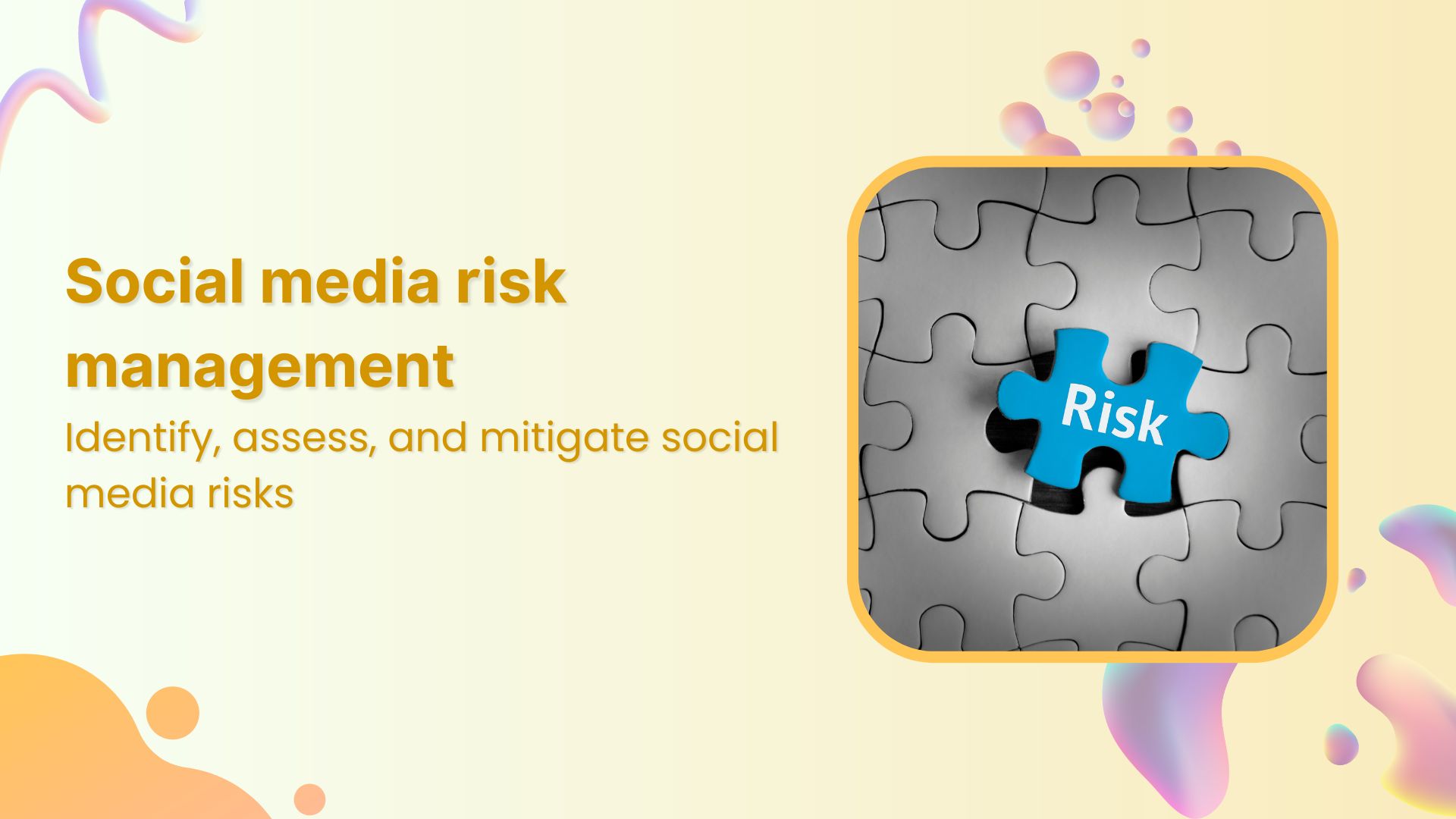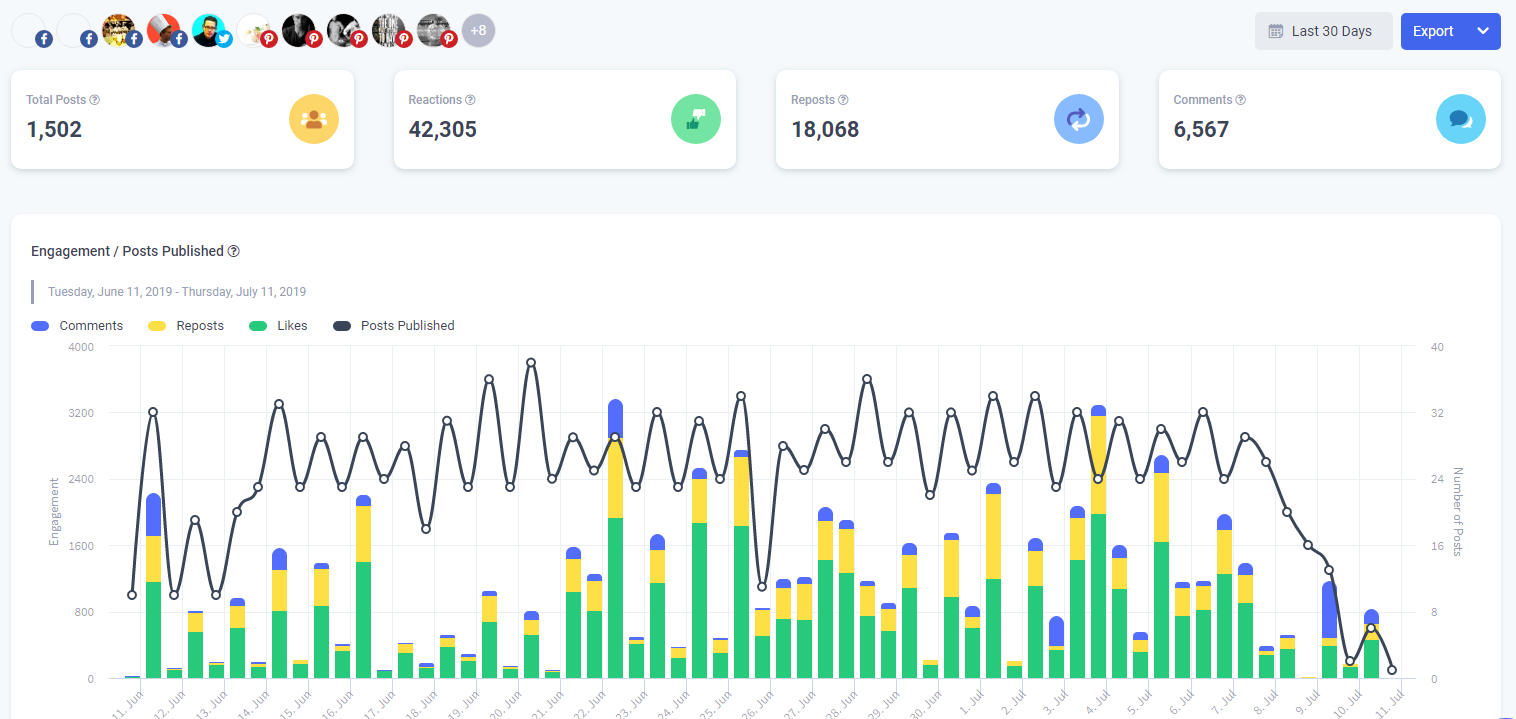Effective social media risk management strategies for 2025

Are your brand’s social channels as safe as they seem?
Every post, comment, and message on social media opens up both opportunities and risks. While social platforms connect brands with a global audience, they also expose them to potential hazards like data breaches, PR crises, and misinformation.
Social media risk management is a proactive strategy for identifying and preparing for these challenges before they escalate. It helps brands looking to maintain their reputation, safeguard customer relationships, and mitigate threats in real-time.
Social media risk management shouldn’t be an afterthought but an integral part of your marketing strategy. With the right planning, companies can address both expected and unexpected risks, ensuring a smoother social media presence that supports broader business goals.
Plan, schedule, share, and analyze content for 15+ social media channels.
Try ContentStudio for FREE
What is risk management in social media?
Social media risk management involves identifying, assessing, and mitigating risks tied to your brand’s online presence. It helps safeguard reputation, customer trust, and business operations.
Take a PR crisis, for example, a misunderstood tweet could spark backlash, damaging your brand image and sales. A solid crisis plan detailing who responds, what to say, and how to show accountability helps minimize harm and reassure audiences.
Ultimately, risk management prepares your brand for challenges, building resilience and maintaining trust even in turbulent moments.
What happens when you don’t effectively manage social media risks?
Failing to manage social media risks can result in significant, often long-lasting, consequences for a brand. A well-established risk management strategy can be the difference between a minor hiccup and a full-blown crisis. Here are four potential outcomes when social media risks go unmanaged:
- Loss of customer trust and loyalty
A social media crisis can swiftly dismantle years of hard-won trust, as Dove experienced in 2017. Known for promoting inclusivity, Dove built a reputation as a champion of diversity in beauty.
A three-second ad showing a Black woman “transforming” into a white woman sparked accusations of racism, leading many to boycott Dove. The incident shows how a single misstep can quickly erode brand loyalty and trust.

- Financial repercussions
Social media crises can have costly financial consequences, as Robinhood experienced in 2021. After limiting trades on popular stocks like AMC and GameStop during a Reddit-fueled surge, the company’s credibility took a hit.
When Robinhood aired a Super Bowl ad claiming “We are all investors,” customers felt betrayed, seeing it as dishonest after the company had restricted average investors. The backlash on X (formerly Twitter) eroded trust and hurt market perception, showing how crises can lead to lost revenue and lasting damage.

- Reputational damage
Things can instantly escalate on social media, and even small missteps can escalate into significant crises. In 2021, Burger King UK faced intense backlash after a tweet reading “Women belong in the kitchen” went viral on International Women’s Day.
Meant to promote gender diversity in the culinary industry, Burger King’s poorly worded post sparked outrage and damaged its image. Though quickly deleted and apologized for, the incident shows how fast social media missteps can erode trust and loyalty.

- Operational disruptions
Social media missteps can disrupt internal operations, as Ketchum’s VP James Andrews learned when he tweeted a disparaging comment about Memphis just before a major meeting with FedEx Ketchum’s largest client and Memphis-based headquarters.
His tweet, “I would die if I had to live here!” sparked backlash, leaving FedEx employees feeling disrespected. Public apologies followed as Ketchum scrambled to manage the fallout, showing how unmanaged social media risks can cause reputational and operational damage.

Key social media management risks to watch in 2025
As brands continue to grow their online presence, understanding common social media risks is crucial to building a secure and trustworthy reputation. Here are the top risks to manage:
1. Reputational risk
A single mistake or negative interaction can harm your brand image. Proactively monitor your channels, engage with feedback, and follow a well-defined crisis communication plan to address issues before they escalate.
2. Security risk
Compromised accounts can lead to data breaches and brand damage. Protect your platforms using strong passwords and MFA, limit user access, and conduct regular security audits.
3. Compliance risk
Failing to comply with privacy laws, ad regulations, or platform policies can lead to legal trouble. Always review content for compliance and ensure your team is trained on relevant guidelines, especially in regulated industries.
4. Operational risks
Inefficient processes or undertrained teams can disrupt social media workflows. Streamline operations with clear guidelines, ongoing training, and social media management tools like:
5. Crisis communication challenges
In a crisis, real-time communication is key. Prepare with pre-approved responses, clear escalation protocols, and regular training so your team can act fast and protect brand integrity.
6. Intellectual property risks
Using copyrighted content without permission or failing to protect your own assets can lead to legal issues. Monitor content carefully, follow brand guidelines, and educate your team on IP best practices.
Easy steps to effective social media risk management
Managing risks on social media is about having the right policies, tools, and culture in place. Here’s a simplified approach to help your brand stay protected:
1. Set clear social media policies
Develop a solid social media policy that defines usage guidelines, access rights, posting rules, and how to handle sensitive content. In regulated industries, collaborate with legal and HR teams for compliance.
2. Provide ongoing employee training
Train new hires on your policies and conduct regular refreshers to cover updates, new platform features, or emerging risks.
3. Strengthen security measures
Use strong passwords, multifactor authentication (MFA), and limit account access to essential team members. Always revoke access promptly when employees leave.
4. Build a crisis management plan
Create a crisis communication plan with clear roles and response protocols for PR or security incidents. Run simulations to keep your team ready.
5. Audit your social channels
Perform regular social media audits to assess compliance, monitor engagement, and identify outdated content or potential risks.
6. Use a social media management tool
Leverage platforms like ContentStudio to streamline publishing, monitor engagement, manage team access, and track analytics. For example:
7. Update crisis plans & policies
Review and refresh your policies and crisis plans regularly based on new risks, lessons learned, or platform updates.
8. Foster cross-department collaboration
Involve legal, PR, and IT/security teams in your risk management process. A collaborative approach improves response times and ensures full organizational alignment.
Controlling social media risk with a centralized management tool
A centralized platform like ContentStudio helps brands streamline operations and minimize social media risks. Here’s how:
- Streamlined access & security
Strong access controls, multifactor authentication, and permission-based roles prevent unauthorized access. Easily update permissions when team roles change to maintain account security.
- Robust content approvals
ContentStudio’s approval workflow ensures content is reviewed before publishing reducing off-brand posts and protecting your reputation, especially when working with agencies or cross-functional teams.
- Unified inbox for crisis management
The social inbox centralizes conversations across platforms, helping teams respond swiftly during PR crises or customer service surges—ensuring transparent, real-time communication.

- Centralized analytics
Social media analytics dashboards track performance and compliance, offering insights into engagement trends and helping spot potential risks early.

- Automated scheduling
Automated publishing and bulk scheduling reduce operational errors while keeping posting consistent and timely minimizing manual effort and the risk of missed opportunities.

Conclusion
Effective social media risk management in 2025 means balancing security, compliance, and crisis communication. With proactive policies, regular training, and the right tools, brands can minimize risks to their reputation, operations, and customer trust.
Social media remains a vital yet complex channel for brand engagement. A solid risk management plan protects your image, nurtures customer relationships, and fuels business growth. To stay prepared, conduct regular audits, update your policies, and involve cross-functional teams in refining your approach. With a strong foundation, brands can embrace social media’s opportunities while staying resilient to its challenges.
Simplified social media marketing for individuals & agencies.
Try ContentStudio for FREE
Frequently asked questions
What are three risks to a company using social media?
Three primary risks include reputational damage from negative feedback, security threats like hacking or data breaches, and compliance issues such as privacy law violations or unauthorized use of copyrighted content. Proper policies and monitoring can mitigate these risks.
What is the biggest risk of social media?
The biggest risk is reputational harm. A single post or interaction can quickly go viral, impacting public perception and potentially leading to customer distrust or loss. Having a robust crisis response plan helps manage and minimize this risk.
What tools help with social media risk management
Social media management tools like ContentStudio offer features such as approval workflows, secure access controls, and real-time monitoring to help manage risks effectively.
How often should I review my social media risk management plan?
You should review and update your risk management plan regularly, ideally quarterly to account for new platforms, emerging risks, and changes in social media trends and regulations.




